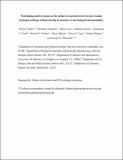| dc.contributor.author | Whitesides, George M. | |
| dc.contributor.author | Shaw, Bryan F. | |
| dc.contributor.author | Arthanari, Haribabu | |
| dc.contributor.author | Lee, Andrew | |
| dc.contributor.author | Durazo, Armando | |
| dc.contributor.author | Frueh, Dominique P. | |
| dc.contributor.author | Pollastri, Michael P. | |
| dc.contributor.author | Bilgicer, Basar | |
| dc.contributor.author | Gygi, Steven P. | |
| dc.contributor.author | Wagner, Gerhard | |
| dc.contributor.author | Narovlyansky, Max | |
| dc.date.accessioned | 2012-11-06T16:24:10Z | |
| dc.date.issued | 2010 | |
| dc.identifier.citation | Shaw, Bryan F., Haribabu Arthanari, Max Narovlyansky, Armando Durazo, Domique P. Frueh, Michael P. Pollastri, Andre Lee, et al . 2010. Neutralizing positive charges at the surface of a protein lowers its rate of amide hydrogen exchange without altering its structure or increasing its thermostability. Journal of the American Chemical Society 132(49): 17411-17425. | en_US |
| dc.identifier.issn | 0002-7863 | en_US |
| dc.identifier.uri | http://nrs.harvard.edu/urn-3:HUL.InstRepos:9871957 | |
| dc.description.abstract | This paper combines two techniques—mass spectrometry and protein charge ladders—to examine the relationship between the surface charge and hydrophobicity of a protein (bovine carbonic anhydrase II; BCA II) and its rate of amide hydrogen-deuterium (H/D) exchange. Mass spectrometric analysis indicated that the sequential acetylation of surface lysine-\(\epsilon\)-NH\(_{3}\)\(^{+}\) groups—a type of modification that increases the net negative charge and hydrophobicity of the surface of BCA II without affecting its 2° or 3° structure—resulted in a linear increase in the total number of backbone amide hydrogen that are protected from exchange with solvent (2 h, pD 7.4, 15 ºC). Each successive acetylation produced BCA II proteins with one additional hydrogen protected after two hours in deuterated buffer (pD 7.4, 15 ºC). NMR spectroscopy demonstrated that these protected hydrogen atoms were not located on the side chain of the acetylated lysine residues (i.e., lys-\(\epsilon\)-NHCOCH\(_{3}\)). The decrease in rate of exchange associated with acetylation paralleled a decrease in thermostability: the most slowly exchanging rungs were the least thermostable (as measured by differential scanning calorimetry). The fact that the rates of H/D exchange were similar for perbutyrated BCA II (e.g., [lys-\(\epsilon\)-NHCO(CH\(_{2}\))\(_{2}\)CH\(_{3}\)]\(_{18}\)) and peracetylated BCA II (e.g., [lys-\(\epsilon\)-NHCOCH\(_{3}\)]\(_{18}\)) suggests that the charge is more important than the hydrophobicity of surface groups in determining the rate of H/D exchange. These kinetic electrostatic effects could complicate the interpretation of experiments in which H/D exchange methods are used to probe the structural effects of non-isoelectric perturbations to proteins (i.e., phosphorylation, acetylation, or the binding of the protein to an oligonucleotide or another charged ligand or protein). | en_US |
| dc.description.sponsorship | Chemistry and Chemical Biology | en_US |
| dc.language.iso | en_US | en_US |
| dc.publisher | American Chemical Society | en_US |
| dc.relation.isversionof | doi:10.1021/ja9067035 | en_US |
| dash.license | OAP | |
| dc.subject | amide H/D exchange | en_US |
| dc.subject | lysine acetylation | en_US |
| dc.subject | mass spectrometry | en_US |
| dc.subject | protein folding | en_US |
| dc.subject | carbonic anhydrase II | en_US |
| dc.subject | protein charge ladder | en_US |
| dc.subject | hydrogen/deuterium | en_US |
| dc.subject | electrostatic potential | en_US |
| dc.title | Neutralizing positive charges at the surface of a protein lowers its rate of amide hydrogen exchange without altering its structure or increasing its thermostability | en_US |
| dc.type | Journal Article | en_US |
| dc.description.version | Accepted Manuscript | en_US |
| dc.relation.journal | Journal of the American Chemical Society | en_US |
| dash.depositing.author | Whitesides, George M. | |
| dc.date.available | 2012-11-06T16:24:10Z | |
| dc.identifier.doi | 10.1021/ja9067035 | * |
| dash.authorsordered | false | |
| dash.contributor.affiliated | Arthanari, Haribabu | |
| dash.contributor.affiliated | Wagner, Gerhard | |
| dash.contributor.affiliated | Whitesides, George | |
| dash.contributor.affiliated | Gygi, Steven | |
| dc.identifier.orcid | 0000-0001-9451-2442 | |


